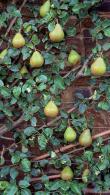Malus Domestica Cox's Orange Pippin Apple
1. Add items to basket
2. Go to the basket
3. Enter your postcode in Delivery Price Check
Plant shape: ¼ standard
Trunk height: 30-40 cm
Pot size: 5 Litres
Rootstock: m27 - Extreme Dwarfing
Plant ID: 13630 W 114
View plant size:Plant shape: ¼ standard
Trunk height: 40 cm
Pot size: 7.5 Litres
Rootstock: m27 - Extreme Dwarfing
Plant ID: 5669 W 114
View plant size:Plant shape: ½ standard
Trunk height: 1-1.1 m
Pot size: 7.5 Litres
Rootstock: m26 - Dwarfing
Plant ID: 12065 W 114
View plant size:Plant shape: Full standard
Trunk height: 1.6-1.7 m
Trunk girth: 6-8 cm
Pot size: 15 Litres
Plant ID: 10500 W 114
View plant size:To check delivery cost add your plants to basket, then you can type your postcode in our Quick Delivery Price Check.

Malus domestica Cox's Orange Pippin, also called Apple Cox's Orange Pippin, is the classic English apple. This UK native variety is noted not only for its delicious apples, but for the lovely blossoms of spring, which have helped earn it the RHS Perfect for Pollinators designation!
Apple trees have been grown in the UK for thousands of years, and Malus domestica Cox's Orange Pippin for a couple of centuries. It was developed in Buckinghamshire in 1825, and has become a favourite for UK gardeners. In April and May, white blossoms cover the tree, followed by an abundant crop of fragrant, delicious dessert apples which are well-suited to fresh eating, as well as for cider-making and for cooking.
Hardy throughout the UK and across continental Europe, Malus domestica Cox's Orange Pippin will grow to a mature height and spread of 4-8 metres in 5 to 10 years. Regular pruning as for all apple varieties is required. Cox's Orange Pippin will produce a heavier crop of fruit if another variety from its pollination group (3) is planted close by for cross-pollination, such as Malus Domestica Discovery.
Plant Malus domestica Cox's Orange Pippin in full sun in a sheltered position with a south or west-facing aspect in fertile, well-drained loam, clay, or sand soil with a neutral pH. It is well-suited to being pruned and trained as an espaliered specimen against a wall or along a fence. Cox's Orange Pippin should be sheltered from salt winds in coastal areas, but will tolerate pollution, so can be grown in city gardens. They are susceptible to deer, so young trees will need protection in country gardens or orchards.
Malus domestica Cox's Orange Pippin can be grown as a specimen tree in a small garden, although it’s a good idea to either plant another variety as a pollinating partner or make sure that a neighbour has one nearby. The spring flowers will be a fragrant delight, the foliage will cast shade in summer, and the autumn harvest of delicious apples will always be welcome! Espaliered against a brick or stone wall along a walkway, it will stay within bounds and provide a long season of interest. On a larger property, Cox's Orange Pippin can be part of a mixed orchard.
Malus domestica Cox's Orange Pippin needs no introduction; it is one of the most delicious and popular of UK apple varieties, and can be a part of any garden, large or small! Lots more choice in our fruit trees section.
















